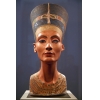|
 Nefertiti, Queen
of Egypt, was considered to be the most beautiful woman at her times and even till
now her makeup style is in vogue, and plastic surgeons try their best to imitate
the shape of her eyes, lips and nose. Style by Nefertiti became in style among
the fashionmongers that even designers create dresses, ethnic jewels and
sandals to look like Nefertiti. Nefertiti, Queen
of Egypt, was considered to be the most beautiful woman at her times and even till
now her makeup style is in vogue, and plastic surgeons try their best to imitate
the shape of her eyes, lips and nose. Style by Nefertiti became in style among
the fashionmongers that even designers create dresses, ethnic jewels and
sandals to look like Nefertiti.
Queen
Nefertiti was
born in 1370 B.C. though Egyptologists cannot still come to one conclusion about
her parentage for sure. Yet, almost all of them guess that the secret is in her
name.
Nefertiti is
translated from Egyptian as «beautiful one is come» which means that she came
from other places than Egypt. There is another version that Nefertiti was the
daughter to Tushratta, the King and Juni, the Queen, from the neighboring
Mitania, a kingdom in Mesopotamia, place of residence of the legendary Aryas.
The parents called the princess Tadukhipa and raised her in traditions of monotheistic
Aryan religion according to which she worshiped the Sun as the one and only Deity.
12 year-old
Tadukhipa was likely sent by her father to Egypt as the present for the Pharaoh
Amenhotep III for the «House of Jewels» (Harem) and became one of foreign
princesses among many others to give birth to King's heirs and to get older in
a lonely. But her fate was more victorious.
Soon after Nefertiti
arrived to Egypt, Amenhotep went aloft and according to ancient traditions all
Pharaoh's wives should have been sacrificed to death together with him and
buried in the tomb. However, the son of the deceased, Amenhotep IV, escaped
Nefertiti from death and married to her. And that was the real love that forced
him to do that. He signed every public document swearing in love to the God and
Nefertiti. He called Nefertiti «The Queen of joy pleasing the Heavens and Earth
with her sweet voice and kind heart».
The reputed
bust of Nefertiti discovered by the German archeologist Ludwig Borchardt in 1912 in the desert is
deemed as a genuine wonder of the world art. Borchardt in secret took the artifact
to Germany and granted to the Berlin museum. In its turn, Egyptian authority
required the artifact back under the treat of fatal damnation by Nefertiti. There
was a rough negative response from the German government, and likewise, the
Fascist leader took the sculpture in his bunker and looked at the silent beauty
for hours.
Currently the
bust is in the Berlin Museum though the government decided for ongoing return
of cultural heritage back to Egypt and Nefertiti will come home soon, perhaps.
The hands of
the ancient craftsman shaped the Queen as a green-eyed beauty with well-lined
black eye-brows, full and sensitive lips, fine nose, resolute cheeks, a
swan-like neck and a tiny shapely figure.
Though, as any
woman of fashion, the Queen was familiar with techniques on how to get more attractive.
She dyed her nails with henna or liquid gold, took bath with sea salt, and
rubbed aroma oils into her skin. Instead of the traditional powder, she used powdered
natural minerals, she outlined her eyes with antimony, made her lips brighter with
berry fondant; she used to wear shear linen dresses and showy jewelry, with two
earring in one earlobe. The spouse to the Pharaoh liked wigs with braids, many-colored
locks and gleaming hair clips.
Nefertiti
was very experienced in politics and she was highly practiced in the skill of
persuasion. She called herself «Nefer Nefer Aton» (Beautiful of Aton). She convinced
her husband to refuse from Deities of his ancestries and take her religion worshipping
the one single God - Aton of the Sun. Soon after Amenhotep IV changed his name
to Akhenaten (pleasing to Aton) and built Akhetaton, a new capital in Sahara.
The Pharaoh announced his wife as a joint Ruler and caused all her orders
executed. Nefertiti decided to destroy ancient temples and persecute priests of
old religion.
The nation accepted
the new religion mutely and prayed in sun rays every morning. The Queen regularly
appeared on the balcony of her temple and rained the Egyptians with golden
coins persuasive in her words that the gold is gifted by Aton, and on holidays
she creatively performed in front of her subjects. Her speeches absolutely
hypnotized the public that they listened to her with open mouths.
The personal
life of Nefertiti was not triumphant though. She gave birth to six daughters and
when the six infant came to world, Akhenaten decided for a new wife. Young Kiya,
his new wife, granted him with a «golden
baby» Tutankhamun ensuring the new generation for the XVIII dynasty. As for Nefertiti,
she had to live out of town raising Tutankhamun as the heir to the throne. In a
year the Pharaoh missing his wife allowed her come back to the palace though
they were not fated to live together.
In a while exiled
priests united and rioted. 40-year-old Akhenaten got blind and was put to
death. Nefertiti was 35-year-old then and she managed
to reign some time as the Pharaoh named Smenkhkare but finally she was killed
to death as well. Rebellions destroyed all the temples in Aton; they annihilated
Akhetaton and all evidence of the royal family. Nefertiti's tomb was robbed and
her body was terribly disfigured.
Yet, in
2003 the British archeologist Dr. Joann Fletcher announced that she discovered
mummy of Nefertiti. The scientists put the anonymous mummy through digital
scanning and determined that the appearance of mummified stranger complies with
the look of Nefertiti in ancient sculptures.
|